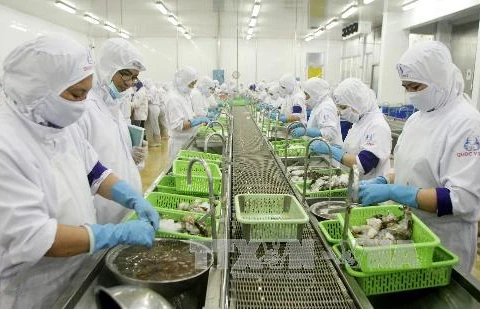 Hon Da Bac (Da Bac Islet), a beautiful landscape in Binh Khanh Tay commune of Ca Mau’s Tran Van Thoi district, attracts hundreds of thousands of visitors each year. (Photo: VNA)
Hon Da Bac (Da Bac Islet), a beautiful landscape in Binh Khanh Tay commune of Ca Mau’s Tran Van Thoi district, attracts hundreds of thousands of visitors each year. (Photo: VNA) Ca Mau (VNA) – Ca Mau province forms the southernmost part of Vietnam and is located in the Mekong Delta. Its eastern side borders the East Sea while the western and southern sides face the Gulf of Thailand, and the north is adjacent to Bac Lieu and Kien Giang provinces.
Blessed by nature with a precious gift - a mangrove forest system - the province is home to an extremely rich ecosystem.
The Ca Mau mangrove forest is the second largest of its kind in the world, following Amazon in South America. It covers more than 63,000 hectares in six districts – Dam Doi, Phu Tan, Tran Van Thoi, U Minh, Ngoc Hien, and Nam Can. The majority of its area is located in the Mui Ca Mau (Ca Mau Cape) World Biosphere Reserve, while 15,000 hectares is in the Mui Ca Mau National Park.
Mangrove forests are a source of livelihood for hundreds of thousands of locals.
In addition, Ca Mau also boasts more than 254km of coastline, a vast fishing ground, and many islets holding strategic locations such as Hon Khoai, Hon Chuoi, and Hon Da Bac, which harbour diverse fauna and flora.
With a V-shaped coastline and three sides bordering the sea, this peninsula-like province holds ideal conditions for the development of mangrove forests, which have become must-visit destinations for anyone setting foot here.
The extensive mangrove forest is among the most diverse ecosystems in Ca Mau.
It is home to 22 plant species, especially those resistant to alkaline and saline water like duoc (mangrove), mam, vet, ban, da, su, coc, da, and cha la, of which duoc is the dominant plant. Besides, there are also 13 mammal species of nine families, 74 bird species of 23 families, 17 reptile species of nine families, five amphibian species of three families, 14 shrimp species, 175 fish species of 77 families, and 133 planktonic species, according to the centre for the Ca Mau mangrove forest studies.
In 2012, the Mui Ca Mau National Park entered the list of Ramsar sites - wetlands of international importance, becoming the 2,088th of its kind in the world and the fifth in Vietnam.
Coming to mangrove forests in Ca Mau, travellers will have a chance to gain memorable experiences as they can explore the rich biodiversity, enjoy the wild and fresh nature there. Tourists to the area can listen to local residents telling stories about their daily life, try catching fish, crab and clam, and taste forest and sea delicacies.
In their mangrove forest tours, tourists also often stop by Ca Mau Cape, the southernmost tip in the mainland of Vietnam, marked with the Ca Mau Cape symbol.
Standing at this point, people will feel overwhelmed by a panorama of vast mangrove forest and the sea, dotted with small islets on the horizon.
Ca Mau is currently a popular destination among visitors from far and wide thanks not only to its rich biodiversity, but also the southern region’s typical features and its important position in the heart of each Vietnamese person.
It is most ideal to visit this province in the dry season, between December and April./.























